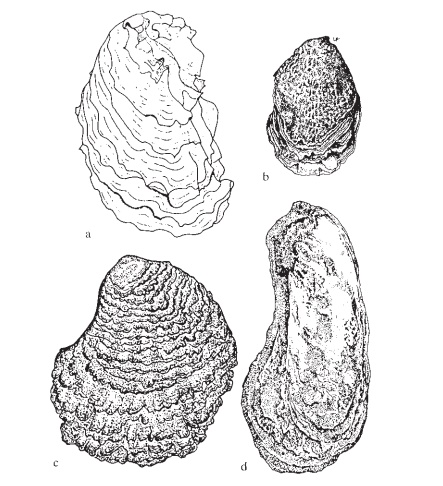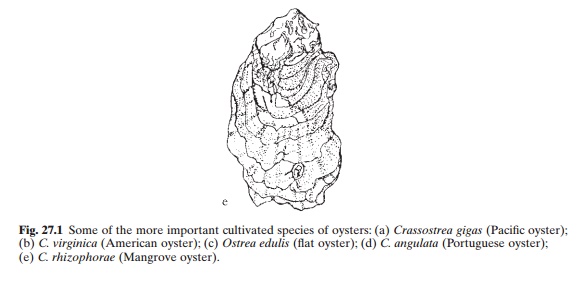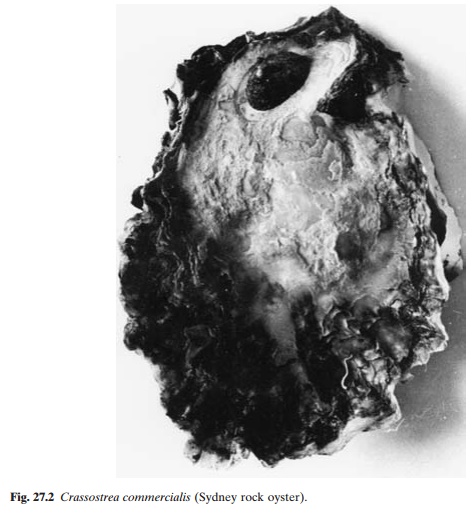Chapter: Aquaculture Principles and Practices: Oysters and Mussels
Oysters
Oysters
Cultivated oysters belong to two genera: Crass-ostrea (the cupped oysters) and Ostrea (flatoysters). Though aquaculture production of cupped
oysters is much higher than that of flat oysters, the latter are held in
greater esteem to be served on the half-shell, and fetch a much higher price in
many countries. The more important species of cultivated oysters are:
Crassostrea gigas (Pacific oyster)
C. virginica (American oyster)
C. angulata (Portuguese oyster)
C. commercialis (Sydney rock oyster)
C. glomerata (Auckland rock oyster)
C. plicatula (Chinese oyster)
C. rivularis (Chinese oyster)
Ostrea edulis (Flat oyster; European
oyster)
Ostrea chilensis (Chilean oyster)
Some of these are illustrated in figs 27.1 and 27.2. The mangrove
oyster, C. rhizophorae, has been
cultivated on a relatively smaller scale in Cuba and Venezuela. A number of
other species of mangrove oysters have been experimentally cultivated in
tropical areas, such as C. tulipa in
Sierra Leone, C. brasiliana in
Braziland C. belcherii in Malaysia,
but no commercial production has so far been reported. The slipper oyster C. iredalei is cultured in some areas of
the Philippines. Most of the cupped oysters grow well at temperatures between
10 and 30°C, though for spawning and larval development temperatures around
20°C are considered optimal. Tropical species like the mangrove oyster, the
Chinese oyster (C. rivularis) and the
slipper oyster tolerate highertemperatures up to 34°C. The flat oyster is less
tolerant of high temperatures and grows well only between 10 and 24°C. High
mortality occurs above 26°C. Unlike the cupped oysters, the flat oyster cannot
withstand continued freezing temperatures. Spawning occurs between 13 and 18°C,
which is the optimal temperature range for larval development as well. On the
whole, flat oysters are more sensitive to temperature variation.


Most oysters attach themselves to hard substrates and can tolerate wide
variations in salinity, often between 5 and 32 ppt. The mangrove and slipper
oyster can tolerate up to 40–45 ppt, even though the optimum is below 37 ppt.
Lower salinities between 15 and 16 ppt are considered preferable for larval
development. The flat oyster is reported to thrive best at salinities above 25
ppt. Being filter-feeders, they draw their food, consisting of phytoplankton
and other organic matter, through an inhalant current of water into the mantle.
From there the selected food passes into the alimentary tract through the
mouth, and the material rejected by the buccal palps is expelled.
Both groups of oysters are protandrous and they generally develop first
as males and then may change to females. Change of sex may occur between
spawning seasons, as in Crassostrea,
or even within the same season, as in
Ostrea species. The spawning behaviour of

Crassostrea is different from that of Ostrea.
Fertilization and larval development are external in Crassostrea, and males and females release gametes into the water.
In Ostrea, the female draws the sperm
expelled by the male into the pallial cavity near the gills by the inhalant
current, and the eggs are fertilized there. The development of eggs and
hatching take place in the pallial cavity. When they reach the stage of
free-swimming veligers, they are expelled into the surrounding water.
Larval development usually takes up to three weeks, starting with the
motile trochophore, followed by the swimming veliger stage. Once the shell
hardens and a foot is developed, the larva is able to crawl around and find a
substrate forattachment. Though any hard surface may be suitable for
attachment, the flat oyster appears to prefer calcareous substrates.
Related Topics